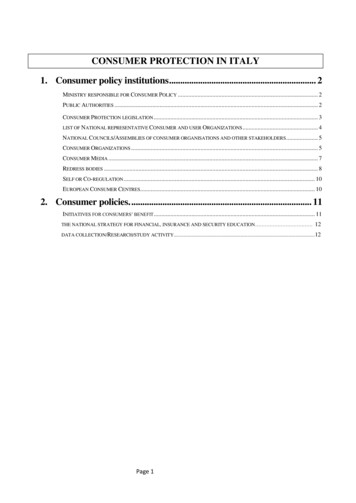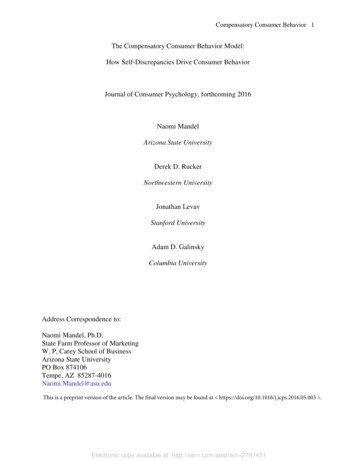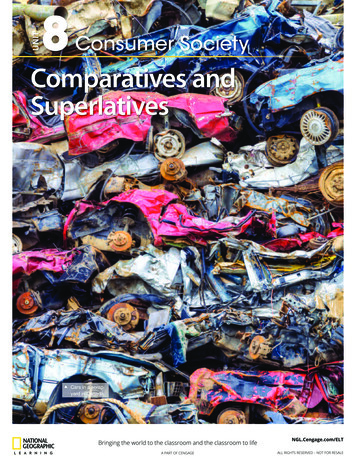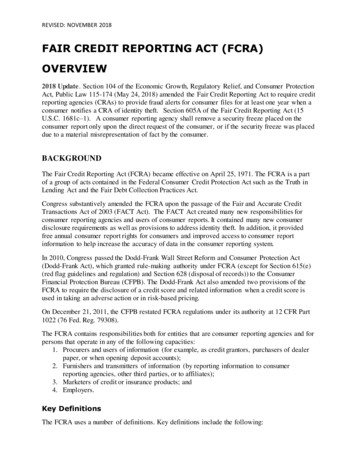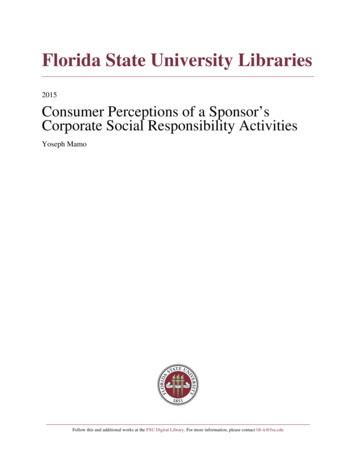
Transcription
Florida State University Libraries2015Consumer Perceptions of a Sponsor’sCorporate Social Responsibility ActivitiesYoseph MamoFollow this and additional works at the FSU Digital Library. For more information, please contact lib-ir@fsu.edu
FLORIDA STATE UNIVERSITYCOLLEGE OF EDUCATIONCONSUMER PERCEPTIONS OF A SPONSOR’S CORPORATE SOCIAL RESPONSIBILITYACTIVITIESByYOSEPH MAMOA Thesis submitted to theDepartment of Sport Managementin partial fulfillment of therequirements for the degree ofMaster of Science2015
Yoseph Zemede Mamo defended this thesis on August 18, 2015The members of the supervisory committee were:Jeffrey JamesProfessor Directing ThesisJoshua NewmanCommittee MemberRyan RodenbergCommittee MemberThe Graduate School has verified and approved the above-named committee members, andcertifies that the thesis has been approved in accordance with university requirements.ii
ACKNOWLEDGMENTSFirst and foremost, praises and thanks to God, the Almighty, for His blessings throughoutthe process to complete this thesis.I am truly honored that I have learned from the best committee members. First of all, Iwould like to give many thanks my advisor, Dr. Jeffrey James. I am truly indebted for hisadvice, encouragement, tremendous support, and opportunities he provided in Florida StateUniversity. I cannot find word to express my wholehearted appreciation for him. Also, I amthankful for my committee members, Dr. Joshua Newman and Dr. Ryan Rodenberg.I am also very grateful that I have worked with the best professor at Florida StateUniversity College of Education and Learning System Institute. Next, I deeply thank my familyand friends. Finally, my thanks go to all the people who have supported me to complete thisthesis directly or indirectly.iii
TABLE OF CONTENTSList of Tables . viAbstract . vii1. INTRODUCTION .12.1.1Sport Sponsorship .11.2Corporate Social Responsibility .61.3Purpose of Study .81.4Research Questions .81.5Significance of the Study . 8LITERATURE REVIEW .102.1Background .102.2Sponsorship .102.2.1Growth of Sponsorship .122.2.2Sport Sponsorship .132.2.3 Sport Sponsorship and Consumer Perception .152.33.4.Corporate Social Responsibility (CSR) .172.3.1CSR in Sport .182.3.2CSR and Sport Sponsorship .212.3.3CSR and Consumer Perception .23METHOD .263.1Design .263.2Participants .273.3Apparatus and Materials .283.4Process .313.5Data Analysis .32RESULTS .354.1Data Collection .354.1.1Data Screening .364.1.2Demographics .374.1.3Independent Variables .404.1.3Dependent Variables .40iv
4.2Assumption Test .434.2.1 Assumption Tests for ANOVA .485.4.3Reliability Assessment .494.4Univariate Test .514.4.1Attitude toward the Sponsor .514.4.2Sponsor Image .534.4.3Attitude toward the Sport Property .534.5Results for the Tukey’s Post hoc Test .544.6Additional Analysis .564.7Summary .60DISCUSSION .625.1Introduction .625.2Attitude toward the Sponsor .635.3Sponsor Image .665.4Attitude toward the Sport Property .695.5Contribution of the Current Study .715.6Limitations and Directions to Future Research .725.7Conclusion .74APPENDICES .75A.CONSENT FORM .75B.QUESTIONNAIRE .76C.HUMAN SUBJECTS COMMITTEE APPROVAL MEMORANDUM .85REFERENCES .86BIOGRAPHICAL SKETCH .97v
LIST OF TABLES3.1 Scales for Measured Items .294.1 Demographic Characteristics .384.2 Independent Groups .404.3 Pre-and Post-test Attitude toward the Sponsor .414.4 Pre-and Post-test Sponsor Image .424.5 Pre-and Post-test Attitude toward the Sport Property .434.6 Testing for Normality for Attitude toward the Sponsor .444.7 Testing for Normality for Sponsor Image .454.8 Testing for Normality for Attitude toward the Sport Property .454.9. The Shapiro-Wilk Test for Normality .474.10. Levene’s Test of Equality of Error Variances .484.11. Internal Consistency of Items .494.12 Univariate Statistics for each Dependent Variables .524.13 Multiple Comparisons for Attitude toward the Sponsor .554.14 Multiple Comparisons for Sponsor Image . 554.15 Paired Samples Test for Attitude toward the Sponsor .574.16 Paired Samples Test for Sponsor Image .584.17 Paired Samples Test for Attitude toward the Sport Property .59vi
ABSTRACTSponsorship of sport properties accounts for approximately two-thirds of all sponsorshipexpenditures (“IEG Sponsorship Report,” 2014). The global sponsorship sector increased from 48 billion dollars to 51 billion from 2011 to 2012 (“IEG Sponsorship Report,” 2014).Organizations have increasingly shifted to sponsorship as a marketing communications vehiclein the hopes that the goodwill that consumers feel toward the cause will transfer to their image(Madrigal, 2001). With the same token, many researchers suggest there is a link between socialinitiatives and an organization’s improved financial performance (e.g., Davis, 1960; Arlow &Gannon. 1982; Ullmann, 1985; McGuire et al., 1988; Waddock & Graves, 1997; Margolis et al.,2003). The main purpose of the current study is to better understand stakeholder perceptions ofsponsors, specifically perceptions about the sponsors’ CSR activities, and the potential impact ofsuch perceptions on sponsors’ image.The current study was quantitative in nature, using a quasi-experimental pre- and post –test control group design. The questionnaire was completed by FSU Sport Management studentsin three different sessions. The survey included a paper based questionnaire which participantsfilled out between viewing two short video clips. Three different groups participated in the studyat three different times; each group received a different scenario pertaining to the sponsor’sinformation and CSR activities. The study included two experimental groups and one controlgroup. All the groups followed the same procedure except the manipulation of the independentvariable. Those in Group 1 read information about the sponsorship activity and the company’sCSR activity; those in Group 2 read about the company’s sponsorship activity; and those inGroup 3 read information about the company. The measures in this study were adapted fromexisting scales. There were 98 participants.vii
A descriptive analysis was conducted to assess the frequency of age (based on date ofbirth), gender, race, education, whether they watched sports (in general), what sport(s) theywatch, hours watching, whether they play a sport, what sport(s) they play, and hours playing asport. I analyzed the data to assess evidence of reliability. Univariate analysis of variance(ANOVA) was used to test for differences. Based on the results I concluded there was nosignificant difference between groups at the pre-test stage for any of the dependent variables. Inthe post-test stage there was a significant difference between groups regarding attitude towardthe sponsor and sponsor’s image. Regarding attitude toward the sport property, there was nosignificance difference between the pre-test and post-test stages. A two-tailed paired t-test wasconducted to assess within group comparisons; the group receiving information about asponsor’s sport related CSR activities and sponsorship had a higher mean score and a significantdifference on the post-test for all dependent variables. The group only receiving informationabout sponsorship activities had a significant difference in attitude toward the sponsor andsponsor image, and the group only receiving company information had a significant difference inattitude toward the sponsor.viii
CHAPTER ONEINTRODUCTION1.1 Sport SponsorshipSponsorship of sport properties accounts for approximately two-thirds of all sponsorshipexpenditures (“IEG Sponsorship Report,” 2013). Working with a sport property may involvesponsoring a sport business, team, school, mega-event, athlete, facility, league, or competition(Tsiotsou, & Alexandris, 2009). Sponsorship is considered an important strategy in themarketing communication mix, and its practice in the sport sector has drawn considerableattention. Sponsorship is also discussed as the financial pillar of many sports properties and canbe considered as a larger part of an event. O’Sullivan and Murphy (1998) asserted thatsponsorship has risen as a core promotion tool: “The growth of commercial sponsorship has beenperhaps the most striking development in marketing communications over the last two decades”(p.349).An estimate of the total U.S. sports market is between 440 to 470 billion (Plunkett,2013). Humphrey and Ruseki (2009) argue that spectator economic activity pertaining to sportsbusiness ranges from 44 to 60 billion in the United States. The global sponsorship sectorincreased from 48 billion dollars to 51 billion from 2011 to 2012 respectively (“IEGSponsorship Report,” 2014). It has been estimated that a total of 3 billion was spent onsponsorships during the 2010 World Cup in South Africa, compared to a total of 1.9 billioninvested in the same event four years before in Germany (Fransen, van Rompay, & Muntinga,2013).Why such substantial investments in sponsorship activity? Over the decades researchersand managers have said a primary goal of sponsorship is to build and maintain strong customer1
relationships (Bagozzi, 1995; Wulf, Odekerken-Schroder, & Iacobucci, 2001; McKenna, 1991).Today sponsorship has become an essential marketing strategy, and important for attractingconsumers. Two primary foci of sponsorship are attracting or targeting consumers, andpromoting the image of the corporation through various channels (Bird, 1998; Cornwell &Maignan, 1998; Meenaghan & Shipley, 1999). Recent studies relating to sponsorship - especiallysport sponsorship – include the idea that working with sport properties is widely preferablecompared to sponsoring other types of properties due to the unique characteristics of sportproperties (Santomier, 2008).Sport remains as the main focus of sponsorship globally, with over 64 percent of allsponsorship activities related to sport (Klayman, 2008). In essence, sponsorship is important tosport properties for their continued operations (Mason, 1999), and as a vehicle through whichsponsors strive to achieve company objectives (Bennett, 1999). Moreover, Shank (2005) assertedthat a sponsoring company can bolster a positive image by associating itself with a sportproperty.There is much that remains to be studied about what makes a sponsorship effective(Cornwell et al., 1998; Speed & Thompson 2000; Plewa & Quester, 2011), including elementsthat have not been previously considered in relation to sponsorship. For example, the extent towhich sponsors seek to address social issues. Lacey, Close and Finney (2010) found that thesponsor’s commitment to social issues has a positive impact on consumer’s assessment of thesponsor. In exploratory work carried out for the Harvard Business Review (Farrelly & Greyser,2006), it was reported that many sponsors recognized the importance of Corporate SocialResponsibility (CSR) associated with sport sponsorship. It is important to provide a cleardistinction between sponsorship and CSR to better understand the relationship between the two2
components. Both sponsorship and CSR have historically been positioned as philanthropicactivity. The definition of sponsorship though, has moved beyond a type of philanthropicactivity. According to Cornwell (1995), sponsorship has changed since the mid-80s; sponsorshiphas moved from a philanthropic orientation to a market-driven orientation. Otker (1988)explained that, “commercial sponsorship as buying and exploiting an association with an event, ateam, a group, etc., for specific marketing (communications) purposes” (p. 77). Godfrey (2009)asserted that, “the origins of CSR lie in philanthropy, the oldest social initiative among Americanprivate enterprises” (p. 700). CSR activities consist of business initiatives which further pursuesome social benefit, beyond the specific financial interest and legal obligations of the company(McWilliams & Siegel, 2000). Thus, sponsorship is focused on improving business aspects of thesponsor and the sponsored property, while CSR activities are implemented to improve aconsumer’s attitude, and positive perception of the company’s image.Sponsorship is a business relationship where support is offered in return for rights andassociation (Sleight, 1989). In the 1950s, marketing oriented sponsorship activity was launched(Lazarus, 1984). In modern sponsorship activity which has been transformed into a marketingpromotional activity (Abratt & Grobler, 1989), the sponsor and the sponsored property develop amutually beneficial business relationship (Abratt & Grobler, 1989). Cornwell (1995) explained thatsponsorship has transformed to strong marketing orientation; pursuit of ancillary activities related tothe sponsored activity; and growth of event sponsorship. Fahy, Farrelly, and Quester (2004)discussed the strategic role of sponsorship in addressing a sponsor’s marketing objectives rely onsponsor’s tangible assets, intangible asset, and capabilities. For example, State Farm sponsors awide variety of events, athletes, and sport properties. State Farm has been an NBA sponsor since2007; the second most active sponsor for the NBA. State Farm is the presenting sponsor of theleague’s games on both ESPN and TNT, athletes, arena (naming right), and activates in over 203
team markets. This insurance company has leveraged the use of the NBA well and it has made agreat impact into their sponsorship (“Fortune.com”, 2014). According to the marketing directorof State Farm, Edward Gold, “When it comes to sport, consumer pay close attention to theproperty than other activities.” Thus, the association between sponsor and sponsored should beconsidered closely than other areas. Consequently, the idea of mutual return puts sponsorshipaside from corporate support (philanthropy, charity, or patronage) which do not expect theadvancement of commercial objectives (McCarville & Copeland, 1994).According to Mitchell (1989), the beginning of CSR began in the 1920s when modernindustries extended beyond boundaries and showed stronger impact on society. CSR is stillexplained and interpreted by many experts and researchers. The idea of CSR has been discusseddifferently due to the sense of values of each era and the expectations of the role of theorganization (Kagata, 2006). Matsumura (2010) argues that through CSR activities companiesnot only give priority to maximizing profit, but also pay attention to delivering benefits to thelarger society. As noted by Mohr, Webb, and Harris (2001), CSR is “ a company’scommitment to minimizing or eliminating any harmful effects and maximizing its long-runbeneficial impact on society” (p. 47). CSR activities consist of business initiatives which furtherpursue some social benefit, beyond the specific financial interest and legal obligations of thecompany. For example, State Farm’s community outreach program helps people recover fromunexpected disaster and damage. As a Corporate Member of the American Red Cross AnnualDisaster Giving Program, State Farm assists the American Red Cross by giving 1 million tohelp ensure that the Red Cross has the resources to proactively assist with national disasterpreparation and recovery efforts. Particularly, there are two main CSR practices adopted byprofessional sports teams (1) they engage in CSR by executing community outreach programs,4
such as athlete volunteerism, community development, youth educational initiatives, andenvironmental programs (Babiak & Wolfe, 2006, 2009); (2) teams often establish independentcharitable foundations to enact their philanthropic activities. In 2010, the NBA launched a socialresponsibility initiative called ‘‘NBA Cares’’ with the commitment of donating 100 million tocharity over 5 years in the areas of literacy, youth and family development, and health-relatedcauses. Basically, the idea pertaining to sponsor’s CSR initiatives are addressed by sponsoringthird-entity (charity, non- profit organization, etc.). As far as the distinction of sponsorship andCSR activities concerned, the basic difference appear on the platform through activities occur,and the expectation of return on investment in terms of profit.Moreover, it has become more common for organizations to attempt to address theirpublic image with various CSR initiatives (Levy, 1999). Thus, sponsors should give emphasis tolinking their strategies for engagement with social activities to efforts to sponsor a particularproperty. Considering that sponsorship may be used to shape consumer perceptions, and the pushon organizations to participate in socially responsible activities and to communicate such CSRcommitment to the stakeholders, I argue that the integration of these two components couldassist in the development of successful sport sponsorship strategies.There are a number of ways the sponsor can engage in or initiate CSR activities,elucidating the communication channels of the sponsors to address CSR have a potential toinfluence consumer’s perception toward the sponsor. Today, due to high competition amongorganizations to sponsor different events, the rising of consumer rights advocacy groups, anddigitally empowered consumers, sponsor activities are apparent for public evaluation. Thus, mostcompanies are responding in different ways as they attempt to embrace CSR activities in theiragenda. Essentially, there are three major approaches that a sponsor can potentially use to5
address CSR activities: (1) the sponsor (organization) is involved in a non-sport related CSRinitiative through funding external agencies. For example, donating resources to water charitiesand literacy improvement programs; (2) the sponsor (organization) is involved with sport relatedCSR activities by funding external agencies. For example, assisting the Women’s SportsFoundation which focuses on the advancement of women and girls through sport and physicalactivities; (3) the sponsor (organization) is involved in both a non-sport related CSR initiativeand sport related CSR activities at the same time. Since this study is an initial attempt to examinethe perception of consumers regarding a sponsor’s CSR activities in relation to sportsponsorship, I plan to examine the second approach. 1In the next section, I define CSR and clarify and differentiate some of its manifestationsand applications, especially as they relate sport sponsorship. I then present the purpose of thestudy, focus of the study, research questions, and significance of the study.1.2 Corporate Social ResponsibilityCSR initiatives have the potential to offer strategic direction to managers who want toenhance their companies’ performance and competitiveness (Breitbarth & Harris, 2008).Pegoraro, O’Reilly, and Lavallet (2009) explain that involvement in CSR initiatives can be apowerful marketing tool that can build up and shape a corporation’s reputation and provide fordifferentiation in a crowded marketplace, thereby providing a competitive advantage. Socialresponsibility has also become increasingly prevalent in the sport industry (Walker & Kent,2009). Throughout the last decade, studies have been conducted in line with the integration of1Sport related CSR activities could also be associated with the sponsored property, or could be throughthe sponsor’s initiatives. In this project I am focusing on sponsor initiated activities.6
CSR in sports (Sheth & Babiak, 2009; Smith & Westerbeek, 2007; Walker et al., 2009; Irwin,Lachowetz, Cornwell & Clark, 2003).In 2005 the Federation International of Football Association (FIFA) become one of theprominent sport governing body to implement CSR initiatives by committing a significant shareof income to CSR related programs (Bradish & Cronin, 2009). By the same token, since 2005“Bigger than basketball,” a campaign from the NBA, has shown the league’s involvement inglobal community outreach initiatives that address important social issues in America and aroundthe world. The league and its teams support a wide range of programs, partners and initiatives inorder to improve the league’s image and profits, and to help cut costs for the future. Moreover,the dramatic growth of CSR activities by professional sport organizations provides someanecdotal evidence of the importance of CSR activities (Babiak & Wolfe, 2009). When we lookback 10 years, CSR did not have a significant role in sports (Kott, 2005; Robinson, 2005).CSR is defined as, “. . . a company’s commitment to minimizing or eliminating anyharmful effects and maximizing its long-run beneficial impact on society” (Mohr, Webb, &Harris, 2001, p. 47). Based on the assumption that consumers will reward organizations for theirsupport of social programs, many organizations have adopted social causes (Levy, 1999).Moreover, researchers have argued that the indirect benefit of CSR implementation by sponsorsplays an important role in establishing their credibility as social citizens both internally andexternally (Plewa et al., 2011). Luo and Bhattacharya, (2006) argued that consumers’ havepositive perception towards sustainable and ethical business practices. As such, the concept ofCSR has been identified in the literature as a mechanism for fostering positive perceptions.Researchers have reported a robust connection between the CSR activities and consumers’ futureattitudes (Becker-Olsen, Cudmore, & Hill, 2006; Klein & Dawar, 2004). Becker–Olsen et al.,7
(2006) found that proactive social initiative programs by organizations results improvement onconsumers’ responses to firms. However, prior researchers have given little attention to theunique aspects of CSR in a connection with bolstering sponsor’s image while sponsors engage inor initiate CSR activity and consumer perceptions of a sponsor1.3 Purpose of the StudyThe main purpose of the current study was to better understand stakeholder perceptionsof sponsors, specifically perceptions about the sponsors’ CSR activities, and the potential impactof such perceptions on sponsors’ image. In addition, after reviewing and examining existing CSRliterature associated with sponsorship, I provided insights into how sponsors can establishconnections with consumers through CSR activities. I reviewed and reported the extent to whichsponsors engage in social issues, and in what CSR activities sponsors engage.1.4 Research QuestionsThe current study was guided by three questions: 1) Does exposure to information aboutsport related CSR initiatives positively increase consumers’ attitude toward the sponsor to agreater extent than just having company information, or information about the company’s sportsponsorship activities? 2) Does engagement in sport related CSR activities significantly increasethe consumer’s positive perception of the sponsor image? 3) Do sport related CSR initiativesconducted by the sponsor foster a more positive attitude toward the sponsored property?1.5 Significance of the StudyThe primary significance of this study is to give direction for sponsors on how tostrengthen their image and reputation by addressing social issues. In essence, this work helpssponsors better understand their consumers’ perception and future attitudes, and the potential to8
be portrayed as a good corporate citizen. The findings of this research can serve as an importanttool for future sponsorship and related topics. The result of the study can provide input formanagers to scrutinize their current sponsorship schemes and practices.9
CHAPTER T
Sponsorship of sport properties accounts for approximately two-thirds of all sponsorship expenditures ("IEG Sponsorship Report," 2013). Working with a sport property may involve sponsoring a sport business, team, school, mega-event, athlete, facility, league, or competition (Tsiotsou, & Alexandris, 2009).

